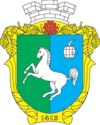Kitsman
| Kitsman Кіцмань | |||
|---|---|---|---|
|
Kitsman City Hall | |||
| |||
| Country |
| ||
| Oblast |
| ||
| Raion | Kitsman | ||
| First chronicled | 1413 | ||
| City rights | 1798 | ||
| Government | |||
| • City Head | Serhij Buleha | ||
| Elevation | 232 m (761 ft) | ||
| Population (2012) | |||
| • Total | 6,904 | ||
| Time zone | EET (UTC+2) | ||
| • Summer (DST) | EEST (UTC+3) | ||
| Postal code | 59300-06 | ||
Kitsman (Ukrainian: Кіцмань, Kicmań, Ukrainian pronunciation: [ˈkʲit͡smɑnʲ], Romanian: Coţmani, German: Kotzman, Yiddish: קאצמאן Kotzman) is a city located in the Chernivtsi Oblast of western Ukraine. It is the administrative center of Kitsman Raion, and is located at around 48°26′33″N 25°45′41″E / 48.44250°N 25.76139°E. The town is about 20 km (12.43 mi) northwest from Chernivtsi on the road to Zalishchyky.
Name
The old surname Kitzman/Kotzman (and variations thereof) originated in Jewish culture, which had gradually become more common in parts of western Ukraine. The name was occupational and derivative of Hebrew roots; shortening the phrase kohen Tsedek ("priest of righteousness"). It was widespread in the Yiddish culture, where -man was the standard suffix applied to commoners' surnames.[1]
History
The first historical mention of Kitsman is dated to 1413, which also appears on the city's crest. Kuzmyn Forest (Codrii Cozminului), woods are situated between Siret and Prut valleys next to the town are named so, because they are traversed by the roads that connect Suceava, the Middle Ages' capital of the Principality of Moldavia, with what was then its boundary town of Cozmin / Kozmyn (modern village Valia Kuzmyna in Hlyboka Raion).
In the Austrian period (1774-1918), Kitsman (known as Kotzman / Kotzmann in German), as part of the Duchy of Bukovina, was the seat of the planning section of the district administration and it had a district court and a state gymnasium, where instruction was given in the Ruthenian (Ukrainian) language. The Ruthenian (Ukrainian) farmers from the 13 surrounding villages brought their produce to the market in Kitsman.
During the period of Romanian rule (1918-1944), the Romanian authorities viewed both the Ukrainians (Ruthenes) and the Jews as enemies of the state whose suppression was one of the goals of the state and.
Notable figures
Remarkably, Kitsman is the birthplace of several nationally well-known musicians Volodymyr Ivasyuk and Ani Lorak.
Jewish community
Out of the population of 6000 that Kitsman had, approximately 700 (11.6%) were Jews who had immigrated to Kitzman from nearby areas of Galicia at the beginning of the 19th century and who dealt mainly with commerce in agricultural products. They also were occupied as craftsmen and were practically the only representatives of the intellectual professions. There were Jews in the ranks of the judges and in the bureaucracy. To name a few, Nathan Seidmann, a clerk in the planning section of the district administration in Kitzman who in his time as a member of the executive committee 2 during the years 1921 to 1927 and intermittently as chairman of the Zionist organization, performed notable service. Before 1914, the Jews and the Ruthenian (Ukrainian) population of the town and the surrounding villages got along well.
References
- ↑ Kitzman family, House of Names
- Site about Kitsman with photos and history (in Ukrainian)
- Kitsman museum of history and ethnography
- Heraldry.com.ua entry for Kitsman, Ukraine
- department of formation of city Kitsman'
Coordinates: 48°26.5′N 25°45.6′E / 48.4417°N 25.7600°E


